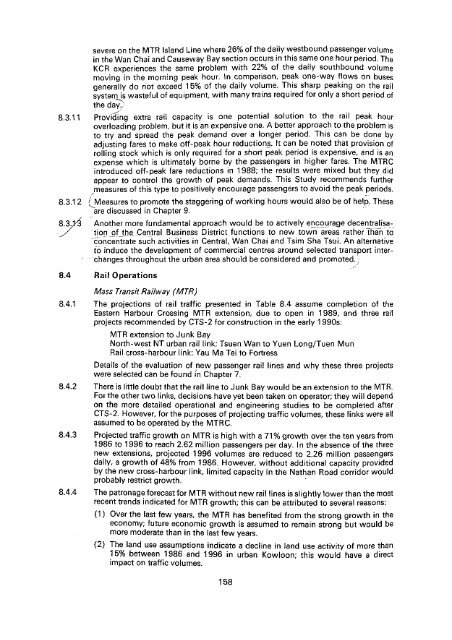Untitled - HKU Libraries - The University of Hong Kong
Untitled - HKU Libraries - The University of Hong Kong
Untitled - HKU Libraries - The University of Hong Kong
- No tags were found...
Create successful ePaper yourself
Turn your PDF publications into a flip-book with our unique Google optimized e-Paper software.
severe on the MTR island Line where 26% <strong>of</strong> the daily westbound passenger volumein the Wan Chai and Causeway Bay section occurs in this same one hour period. <strong>The</strong>KCR experiences the same problem with 22% <strong>of</strong> the daily southbound volumemoving in the morning peak hour. In.comparison, peak one-way flows on busesgenerally do not exceed 15% <strong>of</strong> the daily volume. This sharp peaking on the railsystemjs wasteful <strong>of</strong> equipment with many trains required for only a short period <strong>of</strong>the day/8.3.11 /Providing extra rail capacity is one potential solution to the rail peak houroverloading problem, but it is an expensive one. A better approach to the problem isto try and spread the peak demand over a longer period. This can be done byadjusting fares to make <strong>of</strong>f-peak hour reductions. It can be noted that provision <strong>of</strong>rolling stock which is only required for a short peak period is expensive, and is anexpense which is ultimately borne by the passengers in higher fares. <strong>The</strong> MTRCintroduced <strong>of</strong>f-peak fare reductions in 1988; the results were mixed but they didappear to control the growth <strong>of</strong> peak demands. This Study recommends further/neasures <strong>of</strong> this type to positively encourage passengers to avoid the peak periods.8.3.12 { Measures to promote the staggering <strong>of</strong> working hours would also be <strong>of</strong> help. <strong>The</strong>se"are discussed in Chapter 9.Another more fundamental approach would be to actively encourage decentralisation<strong>of</strong>_the Central Business District functions to new town areas rather Than toconcentrate such "activities in Central, Wan Chai and Tsim Sha. Tsui. An alternativeto induce the development <strong>of</strong> commercial centres around selected transport snter-- changes throughout the urban area should be considered and promoted.)8.4 Rail OperationsMass Transit Railway (MTR)8.4.1 <strong>The</strong> projections <strong>of</strong> rail traffic presented in Table 8.4 assume completion <strong>of</strong> theEastern Harbour Crossing MTR extension, due to open in 1989, and three railprojects recommended by CTS-2 for construction in the early 1990s:MTR extension to Junk BayNorth-west NT urban rail link: Tsuen Wan to Yuen Long/Tuen MunRail cross-harbour link: Yau Ma Tei to FortressDetails <strong>of</strong> the evaluation <strong>of</strong> new passenger rail lines and why these three projectswere selected can be found in Chapter 7.8.4.2 • <strong>The</strong>re is little doubt that the rail line to Junk Bay would be an extension to the MTR.For the other two links, decisions have yet been taken on operator; they will dependon the more detailed operational and engineering studies to be completed afterCTS-2. However, for the purposes <strong>of</strong> projecting traffic volumes, these links were allassumed to be operated by the MTRC.8.4.3 Projected traffic growth on MTR is high with a 71% growth over the ten years from1986 to 1996 to reach 2.62 million passengers per day. In the absence <strong>of</strong> the threenew extensions, projected 1996 volumes are reduced to 2.26 million passengersdaily, a growth <strong>of</strong> 48% from 1986. However, without additional capacity providedby the new cross-harbour link, limited capacity in the Nathan Road corridor wouldprobably restrict growth.8.4.4 <strong>The</strong> patronage forecast for MTR without new rail lines is slightly lower than the mostrecent trends indicated for MTR growth; this can be attributed to several reasons:(1) Over the last few years, the MTR has benefited from the strong growth in theeconomy; future economic growth is assumed to remain strong but would bemore moderate than in the last few years.(2) <strong>The</strong> land use assumptions indicate a decline in land use activity <strong>of</strong> more than15% between 1986 and 1996 in urban Kowloon; this would have a directimpact on traffic volumes.158
















